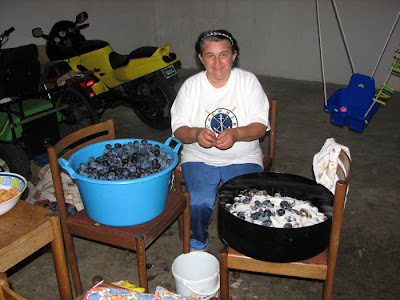The picture below is from a large grocery store. Please note that I was not able to capture the entire length of aisle of wine and that there was another row facing this one. On the left is Kent choosing his dessert wine to serve with the biscotti.
Claudia, who was in charge of our rental, told me that wine with a rooster on the label around the neck, was supposed to be of higher quality, but she wasn't convinced this was always so. I had tried one bottle of Italian wine already and was quite shocked at how dry is was (you could interpret that as a negative) so I asked Claudia how I could find a wine that was nice for drinking before dinner. She said I needed an aperitif wine and she helped me find one that was not too much like vinegar. But that was the last time I found a pleasant wine in Italy. Even though I picked up a number of different bottles of Chianti with roosters on the label, I just couldn't enjoy them. Perhaps if I tried a 30 Euro bottle I might like it, but I think that Chianti is just not my kind of wine.
I have made Amarone from a kit here at home and was looking forward to trying the real thing in Italy. However at 17 (or was it 19) Euros a bottle, that experience was not to be had.
Doing some research into wine before I went to Italy I was surprised to find that there is a great deal of white wine produced there. While I generally prefer red wine, when Rory suggested that we give an Italian Pinot Grigio a try I agreed. To my very pleasant surprise it was not dry. So I guess I should just have stuck to whites.
Liana with a monster bottle of cheap wine, (once again displaying my talent for snapping the shutter at a bad time).
Liana's favourite wine is Barbera, a red made in the north-west of Italy. I lugged a bottle of it from Slovenia and it too was pretty dry. When Liana saw Barbera on the shelves in Tuscany she just had to have some. However it turned out to be bubbly. I think we unintentionally ended up with bubbly wine two or three times!
Evidently so much of of the wine that is produced in Italy is consumed within the country they don't have much left to export!





























































